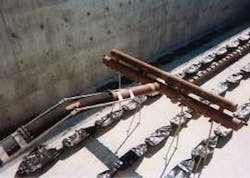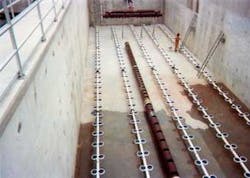Municipal Wastewater Rediscovers Improved SBR Technology
By Ray Hamilton and Vernon Webb
Gone are 8-track tapes and tape decks. Gone are vinyl records and record players. Both replaced by newer, faster, smaller technology. Thirty years ago a multi-media sound system consisted of three or four shelves filled with cassette tape deck, record player, radio, tuner and at least two separate speakers. It was a bulky, space-consuming sound system, but it was state-of-the-art at that time. Now a multi-disc compact disc player, cassette player, AM/FM radio, and speakers come in one box that can be carried around. Technology improvements created better ways to get music to listeners.
All industries are experiencing technology changes that either eliminate systems or improve systems that ultimately provide the desired end result. In the wastewater industry, sequencing batch reactors (SBR) are an older technology that has endured through the last 80-plus years in industrial wastewater treatment.
Early on, SBR units were used mostly for industrial applications because the wastewater was more consistent, and it was a simpler process. But specific SBR technology advances and equipment improvements, like aeration devices and control systems, as well as increased reliability of computer systems have re-ignited interest and use of updated, state-of-the-art SBR systems for municipal wastewater treatment.
In one unit, an SBR can accomplish equalization, biological treatment, and secondary clarification with a timed, controlled sequence. Each of these processes occurs in separately constructed and equipped units of a conventional activated sludge system.
An SBR is an activated sludge system that works based on time rather than space, whereas a conventional activated sludge system requires more space.
How SBRs Work
In a single-chamber SBR, multiple biological environments are created in sequence and maintained for optimal lengths of time based on each facility's specific needs. Each specific environment nurtures each specific type of biological life necessary for optimum performance at exactly the right time and right stage of the process. For example, one type of bacteria absorbs excess phosphorous in the aerobic condition when aeration occurs, the bacteria are conditioned for this luxury uptake in the anoxic and the anaerobic stages.
The mixed liquor organism (the biological "soup" in the basin) quality and quantity is key. With conventional systems, the mixed liquor is settled in the clarifier and pumped back to the head of the plant. The biological life is then recycled to maintain sufficient quantities. However, in the SBR, the biological life continues to live and work in the unit exactly as needed, when needed. These biological life forms live in the system longer so they become stronger, more diverse populations, which are more effective during the treatment process.
An SBR can include fill, react, settle, draw, and idle steps. The entire SBR treatment cycle can range from four to six hours depending on the model purchased. Compare the SBR cycle time with the approximate 24-hour cycle time of a conventional extended aeration system.
Depending on the specific facility's needs and goals, one of three processes can occur during the "fill" step. These different fill processes include static fill, mixed fill, or aerated fill. "Static fill" is when influent is mixed with existing biomass without any prior mixing or aeration having occurred when the mixing process begins. "Static fill" can be compared to using selector compartments in a conventional activated sludge system. "Mixed fill" is mixing influent organics and biomass into the process. "Aerated fill" consisted of aerating the SBR contents to start an aerobic reaction.
Biological reactions are finished during the "react" stage so that nitrification or denitrification and phosphorous removal can be accomplished.
During the "settling" stage, no influent gets in to disturb settling in a true SBR. However, some manufactures have modified SBR systems with long narrow tanks that allow flow to enter during both the "settling" and "draw" steps.
In the "draw" step, a decanter is used to remove treated effluent out of the top of the tank while the bacteria settle at the bottom. A more recent, major technology improvement in the SBR, according to Hamilton, allows effluent to be drawn out of the system even when the effluent or water level is at a variable, or non-consistent, level.
The "idle" step varies in length based on plant operation and flow rate at any given time in the process. No treated effluent is removed, nor is influent added during the "idle" step. Once this step is completed, the whole process begins again with the fill step.
"The SBR allows operators to actually operate the plant instead of spending most of their time maintaining the plant," said Bobby Whisenant, City of Pearland Water Production and Wastewater Treatment Superintendent. "For instance, conventional plant operators spend about half their weekly hours cleaning weirs, whereas an SBR plant operator can clean the weirs in about 20 minutes a week." A conventional treatment system may have about 300 feet of weirs while and SBR system has about 40 feet of weirs.
"Operators do not have to spend time maintaining return pumps or calculating return rates with an SBR because there are no return pumps or return processes," Whisenant said.
But an SBR can often require many hours of operator training to learn the processes for setting up and maintaining unit timing and controls. The need for hands-on operations and calculations with a conventional wastewater treatment system require philosophical and practical changes for the operator as well. It is not wise to cut corners (for time or money) on the operator training part of the SBR start-up process.
The SBR manufacturer creates a plant-specific "Programmable Logic Controller" (PLC) to operate the SBR within specific parameters for a specific treatment plant. The PLC operates all flows, aeration, valves, timers, lights, in fact, the entire process. The PLC computer tells the SBR when to switch from one treatment stage to the next. Once the PLC is on-line and properly programmed, the process requires little outside input.
The SBR process can be tricky for long-time operators, not because the system itself is difficult, but rather that it is not necessary for the operator to spend time second-guessing or handling the process or computer. Under most conditions, with the SBR, there is less need for an operator to be hands-on and reactionary. If a situation occurs where operator input is needed, the program will sound an alarm automatically.
If the same hands-on techniques used with conventional systems are used with SBR, the process can be completely thrown out of sync and create bigger problems. For instance, if an operator tries to recalibrate a valve because the tank appears to be filling too quickly or too much, and the PLC is not updated with these changes, it can end up overflowing the down stream units. The PLC is programmed to realize that this situation will happen and will make the appropriate adjustments to cycle times on its own. So, an operator needs to be familiar and comfortable with the hands-off SBR process, and know how to properly make changes to the system through the PLC computer, only when necessary.
On Line With SBR
The City of Pearland, population of about 40,000, is in Brazoria County, Texas, in the southern part of the rapidly growing Greater Houston Metropolitan Area.
The City of Pearland's Southwest Environmental Center (SWEC) is a 100-acre site that includes a 2 MGD sequencing batch reactor wastewater treatment plant on 10 acres, as well as detention ponds, nature trails, and parks. The SBR service area includes 11,500 acres with an ultimate capacity of 10 MGD.
The project began with Carter & Burgess, Inc., assisting the City of Pearland in acquiring State Revolving Fund (SRF) financing for the new wastewater treatment plant. Once the SRF loan was awarded, Carter & Burgess guided the City of Pearland through each step of the process until construction was completed in mid-2000.
Carter & Burgess approached this project's bid and design phases very differently from most conventional plants. Since different SBR manufacturers break down units and process cycles uniquely for specific products, including piping and electrical wiring, Carter & Burgess established basic bid criteria for manufacturers to bid from before plant design occurred. This additional bid step enhanced overall project integrity and continuity. Once SBR equipment was selected, engineers designed the facility around the SBR to get the best process fit.
The SBR units were ultimately selected for the City of Pearland because the treatment process could be contained within each SBR unit. Four units were constructed to allow maximum cycle time flexibility. Depending on influent flow rates, any number of basins can operate, and the plant can run efficiently when a basin is taken out of service for maintenance. The construction of four SBR basins replaced the need for construction of multiple aeration basins and multiple clarifiers while reducing the operation and maintenance costs associated with conventional clarifiers and aeration basins.
The SWEC SBR wastewater treatment plant was designed with an average daily flow capacity of 2 MGD, a peak flow rate of 8 MGD and influent BOD5 and TSS concentrations of 210 mg/l and 220 mg/l, respectively. The plant's four SBR operate at variable times. One SBR unit is always filling while others operate at various stages. Utilizing this system, the plant has consistently meet effluent requirements.
The 2 MGD Pearland SBR was constructed for approximately $5.3 million. A cost analysis based on "dollar-per-gallon" was completed for the SBR and two other Houston area conventional treatment plants bid at the same time. The Missouri City plant and the Tomball plant were each 1.5 MGD. The Missouri City plant cost $5.40 million and the Tomball plant cost $5.83 million. The cost-per-gallon at the Missouri City plant was $3.60, while the cost-per-gallon at the Tomball plant was $3.89. The cost-per-gallon at the City of Pearland SBR was $2.67. These calculations show nearly a $1 or more cost-per-gallon savings at the SBR over either of the conventional plants.
"We estimated the monthly electrical bill for a conventional treatment system at about $21,000 but the highest monthly SBR plant electric bill has been about $7,200," Whisenant said.
The City of Pearland has been pleased with the effectiveness and efficiency of the SBR plant. The City plans to expand this facility with additional SBR units to increase treatment capacity by adding another 2 to 4 MGD. Since the City of Pearland brought the initial SWEC sequencing batch reactor plant on line, it constructed the 2 MGD Far Northwest Environmental Center, which went on-line in August 2003.
Conclusion
"Everyone with the City of Pearland is pleased with the SBR construction cost savings, operation and maintenance ease, and electrical cost savings. We have recommended that new plant constructions or expansions be SBR systems," Whisenant said. "I had never heard of sequencing batch reactors when I came to the City of Pearland, now I hope I never have to work with conventional wastewater systems again."
By omitting clarifier and aeration basin construction, as well as omitting other conventional process equipment purchase and installation costs, the SBR can provide considerable facility cost savings. Once operators are efficiently trained with the SRB and its PLC, operation is enhanced and maintenance time is greatly reduced.
Wastewater permit limits get tougher. Water quality standards get stricter. Water supplies become less available. Space for treatment plant construction or expansion gets more limited. Wastewater treatment plant owners and operators know that wastewater technology innovations and improvements must advance to meet any combination (if not all) of these challenges. Improved SBR technology may just be the answer.
About the Authors:
Ray Hamilton, P.E., Public Works Manager for Carter and Burgess, Inc., Denver, CO, can be reached at 303-820-5229. He has 30 years of experience in the wastewater industry. Vernon Webb, P.E., Carter and Burgess, Inc., Project Manager in the Houston, TX, office has eight years of experience. He can be reached at 713-803-2316.




